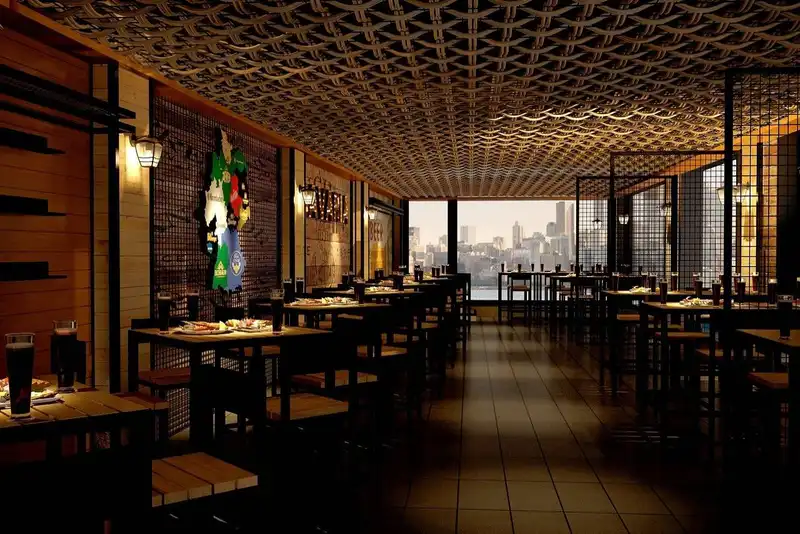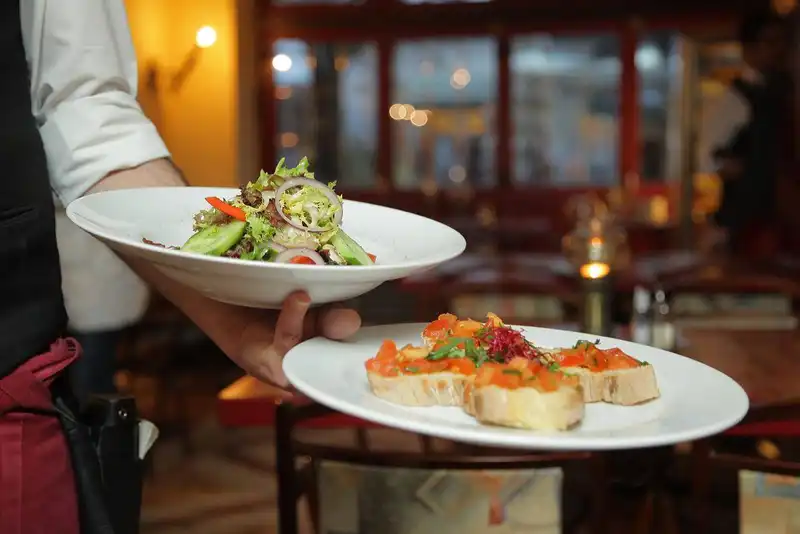What is the profit margin for the restaurant industry?
There is no definitive answer to this question as profit margins can vary greatly from one restaurant to the next. However, some industry experts have estimated that the average profit margin for restaurants is around 3-5%.
Higher Profit Margin for Restaurant Industry - 4 Measures to Adopt Right Away
What's the Average Profit Margin for the Restaurant Industry?

Let's start with understanding what is profit margin. Profit margin represents the profit a company makes for every dollar of revenue. It is calculated by dividing net income by total revenue. A company's profit margin can offer insights into its pricing strategy, operational efficiency, and overall profitability.
If you own a restaurant business or are planning to start one, you must be aware of the various fixed and variable costs involved. These include operating expenses and other overhead expenses like rent and utilities (such as electricity and water bills), the cost of supplies and equipment, point-of-sale (POS system) and other restaurant management software, processing fees, marketing and advertising, equipment repairs, and general day-to-day management costs. In addition, there are also labor costs (cooks, waitstaff, janitorial staff, and managers) to be factored. With all of these fixed and variable costs, it's important to know how much money you'll need to generate to keep your business afloat.
At times, food and ingredient costs will fluctuate with the economy, while labor costs may increase or decrease depending on the number of employees needed to run the business smoothly. For instance, currently, due to the pandemic, there is an acute labor shortage in the restaurant industry, which has led to a rise in wages. In addition, utility costs such as electricity and water bills, can vary monthly. You will have to take all of this into account. Once you know the total costs incurred in running a business, it will become easier to improve your average restaurant profit margin.
However, it's difficult to be profitable in the food and beverage industry. The average profit margin ranges anywhere between 3-15%. In 2017, the average profit margin for the restaurant industry was 3.7%, a slight decrease from the previous year. It means that for every $100 a restaurant makes, they only get to keep $3.70.
Of course, there are always exceptions to this rule, with some restaurants making much higher profits and others barely scraping by. Food trucks, in general, tend to have relatively low overhead costs compared to brick-and-mortar restaurants, which can lead to higher profit margins. Many food trucks report an average profit margin between 10% and 15%. In the case of quick service restaurants, their location, the size of the establishment, and whether it is franchise-based or independently owned -- all play a part in the final profit margin. As far as full service restaurants are concerned, they tend to have a lower profit margin than fast food joints as the latter require smaller staff. Additionally, restaurants in tourist areas or near business districts often have higher margins (because of better sales volume) than in residential neighborhoods.
One of the main reasons the restaurant industry's profit margins are so low is competition. There are many different restaurants, all competing for the customer's attention and money. To stand out from the crowd, restaurants have to offer something unique or provide an exceptional dining experience.
How is the Profit Margin for a Restaurant Calculated?
There are a few different ways to calculate the net profit margin for a restaurant. The most common method is to take the total revenue from the restaurant and subtract the cost of goods sold (COGS). This will give you the gross profit for the restaurant.
When you subtract operating expenses, such as rent, utilities, payroll, and maintenance, you're left with the net profit. Net profit margin is net profit divided by total revenue.
Net profit is calculated by subtracting expenses from total revenue. To calculate it, you'll need knowledge of your business's total revenue and expenses for a given period, whether monthly or annually. If you don't have the information available, you can find it by reviewing your business's financial statements. Look for line items that list your total revenue and expenses, then subtract the latter from the former to calculate your net profit. Once you have this figure, divide it by your total revenue to arrive at your net profit margin percentage.
In sum-
Net Profit = Total Revenue / Total Expenses
Net Profit Margin = [Net Profit Revenue] x 100
Profits are notoriously lean in the restaurant industry.
By adopting certain measures, however, you can improve your bottom-line.
No. 1- Improve Your Profit Margin With a Robust Supply Chain
Supply chain management helps restaurants optimize their operations and increase their profits. Restaurant Management is all about optimizing every process. By managing the supply chain effectively, restaurants can reduce costs and improve quality control. In addition, supply chain management can help restaurants to forecast demand and manage inventory more efficiently. Ultimately, these lead to an increase in average restaurant profit margin.
A robust supply chain management can greatly impact restaurant profit margins. Here's how it can help-
- Supply chain management can help optimize inventory levels, reducing food spoilage and storage costs. It will also ensure that restaurants have the supplies they need, reducing the chance of expensive shortages.
- Streamlining the procurement process can help save money purchasing supplies and ingredients.
- Transportation is a major expense for restaurants, and supply chain management can help minimize this cost by finding more efficient routes and carriers.
- Effective supply chain management provides visibility into the entire operation, which can uncover hidden costs and inefficiencies. Addressing these problems can lead to significant savings.
- An efficient supply chain can also help improve communication between suppliers and restaurants, preventing misunderstandings that could lead to costly delays or errors. As a result, it can help improve a restaurant's bottomline and identify opportunities for cost saving.
- An efficient supply chain management leads to better inventory management. As a result, it can assist in menu planning, ensuring that restaurants have access to the ingredients they need while helping to control food costs.
- In addition to direct cost savings, an effective supply chain management system can improve customer satisfaction by ensuring the timely delivery of fresh, high-quality products. Customers who are happy with their dining experience are more likely to return in the future and recommend the restaurant to others. Both, repeat customers and positive word-of-mouth can translate into better Business Growth for a restaurant.
No. 2- Improve Your Profit MarginWith Loyalty Programs
In today's world of business, customer loyalty is more important than ever. A loyal customer base can provide a restaurant with a steadier income stream and repeat business. One way to increase customer loyalty is with a loyalty program. A major reason why loyalty programs can help increase your restaurant profits is that they result in increased customer retention. A study found that 80% of customers are more likely to continue doing business with a company with a loyalty program. And it's not surprising because who doesn't love feeling appreciated and getting rewarded every once in a while? So when customers feel valued, they're more likely to continue spending their hard-earned money at your restaurant.
A well-run loyalty program can offer several benefits to a restaurant, including-
- Increased Customer Retention- Many restaurant industry statistics suggest that loyalty programs can increase the customer retention rate of a restaurant by over 25%. Customers are more likely to return to a restaurant that offers them rewards, discounts, and other perks. In addition, loyalty program members spend up to 20% more than non-members.
- Improved Order Frequency- Loyalty program members visit restaurants more often and order more items when they visit. It is because they know they can earn rewards for their patronage. As a result, loyalty programs can help to increase a restaurant's sales by up to 4%.
- Higher Average Order Value- Restaurants with loyalty programs increase their average order value by around 3%. It is likely because customers feel they need to spend more to earn rewards or reach higher tiers in the program.
- Reactivation of Inactive Diners- Loyalty programs are likely to reactivate up to 28% of inactive users, resulting in increased restaurant profits. In addition, diners who haven't visited in a while may be enticed back with special offers or loyalty points (through social media, emailers or other platforms) that can be redeemed for freebies or discounts.
- Attract New Customers- In addition to retaining current customers and reactivating inactive ones, loyalty programs also attract new business. 35% of diners say they would try a new restaurant if it had a good loyalty program.
No. 3- Improve Your Profit Margin by Leveraging AI

Artificial intelligence (AI) can be used in various ways to increase a restaurant's profit margin. For example, AI can improve stock management, minimize waste, optimize staff scheduling, and target marketing efforts. In addition, AI-powered chatbots can handle customer inquiries, freeing up staff members to focus on other tasks. Ultimately, artificial intelligence can help restaurants boost their bottomline by automating various tasks and processes.
Here are a few ways in which AI can be helpful-
- Improve inventory management- Keeping track of inventory is crucial for any business, but it can be especially challenging for restaurants with perishable goods. AI can help streamline the process by keeping track of expiration dates and sending alerts when supplies run low. Having a handle on your inventory also lets you know the exact ingredient quantity you need for each dish on your menu. If you run out of an ingredient unexpectedly, emergency orders can be costly, in terms of money and time lost while waiting for the delivery. Planning with inventory management means avoiding these situations altogether.
- Automating the ordering process- With AI, online ordering platforms can automate the entire ordering process from start to finish. It saves time, improves efficiency, and can increase restaurant profits.
- Incorporating recommendations- AI can help introduce new menu items that are likely to be popular and generate higher profits by identifying weather patterns and customer behavior. In addition, by analyzing past orders and customer preferences, AI-powered online ordering platforms can make recommendations to customers that may increase their spending. For example, if a customer orders a particular dish frequently, the platform could suggest add-ons or side dishes that complement their meal.
- Analyze customer feedback- Reviewing customer feedback can help a restaurant understand what changes need to be made to improve the dining experience and bring in more business.
- Increasing marketing effectiveness- Restaurants can use AI to target their marketing efforts and improve ROI. It can automate many tasks associated with marketing campaigns, including segmentation, ad creation, and targeting of specific demographics. AI-based marketing tools can help identify potential customers, analyze customer behavior, and develop targeted campaigns that convert leads into paying guests.
- Reduce food waste- By analyzing sales and customer behavior patterns, AI can help restaurants better predict demand to avoid over-ordering supplies, and reduce food waste.
- Create a loyalty program- Many restaurants offer loyalty programs that give customers rewards for frequent visits, but these programs can be difficult to manage without AI. With its ability to collect and analyze data, AI can help simplify running a loyalty program.
- Smarter Kitchen Operations- In commercial kitchens, AI is used in several ways to improve efficiency and quality control. For example, some restaurants use robots for basic prep work like chopping vegetables or portioning meat, while others employ computer vision systems to inspect a dish's temperature control, signs of contamination, and other food safety issues before they leave the kitchen.
You want to improve your restaurant's profit, but you've run out of ideas.
This article will help you out.
No. 4- Improve Your Profit Margin With Efficient Employee Scheduling
A restaurant business can increase profit by efficiently scheduling and managing employees. Implementing an online scheduling system like Zip Schedules can automate scheduling and managing employees. In addition, online scheduling systems can provide features that allow managers to track labor costs and optimize staffing levels in real time, which can help to reduce labor costs further and improve profitability.
There are more ways that better employee scheduling can work in favor of a business. They include-
- The right mix of employees scheduled during peak times can directly impact how much revenue your restaurant brings in.
- Analyzing past sales data can give you a good idea of when you'll need the most staff on hand so that you can schedule accordingly and avoid overstaffing (and its associated costs).
- Automated employee scheduling software can take all the guesswork out of creating an effective schedule, while making allowances for the unexpected. It also helps in reducing labor costs without compromising on quality or service.
- Automated scheduling helps you comply with labor laws and avoid costly fines or penalties (again, an additional cost) by ensuring that your employees are scheduled as per federal and local laws.
- A centralized scheduling system also improves communication and collaboration between management and staff, leaving smaller room for error, which may result in losses.
- Mitigate the risk of overextending your workforce during busy periods by incorporating breaks and lunches into the schedule.
- Boost morale and reduce turnover by showing your employees that you respect their time outside of work.
- Well-rested and alert employees are also less likely to make mistakes on orders or in food preparation, which can cost your business dearly.
- More productive employees mean less waste and better use of inventory, ultimately saving your restaurant money.
- Reduced turnover means you will always provide the same great service. It will have regular customers returning, maximizing profits while maintaining a healthy work/life balance for your employees. It's a win-win!
Final Word

There are several reasons why improving your restaurant profit margins are important. Higher profits mean your business generates more money, which can be used to invest in growth or expansion. A profitable business can help weather tough economic times by providing a cushion against losses. It will also make your business more attractive to potential investors.
However, while implementing different methods to increase your profit margin, it is important for restaurant owners to be strategic. For example, leveraging technological solutions have become trendy. and, of course, tech-enabled and AI solutions are helpful. But while investing in energy-efficient kitchen equipment can help save money on utilities, overspending on trendy gadgets that don't benefit the business can quickly eat into profits. Therefore, it always makes sense to ensure that every method you opt for, offers great return on investment.
It's difficult to rake in huge profits in the restaurant industry.
Yet, there are ways you can do this. Here's how. . .
